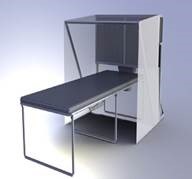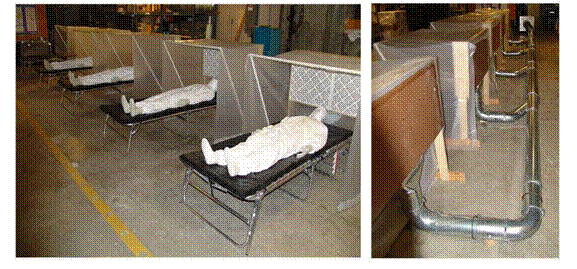NIOSH Ventilated Headboard Provides Solution to Patient Isolation During an Epidemic
Posted on by
To protect healthcare workers, other patients, and visitors from exposure to airborne infectious diseases, patients in hospital settings sometimes need to be placed in airborne infection isolation rooms (AIIRs). AIIRs contain specific engineered features to isolate and more-quickly remove potentially infectious patient aerosols so that they do not infect others. Isolation rooms are expensive, costing about $30,000 more to construct than a typical patient room. As a result, not all facilities have isolation rooms or have enough isolation rooms to handle an epidemic/pandemic.
To address the need for multiple isolation rooms, the National Institute for Occupational Safety and Health (NIOSH) developed the Ventilated Headboard to isolate patients while protecting healthcare personnel from airborne infectious diseases. The ventilated headboard is inexpensive, easy to erect, safe, and scientifically proven.
The ventilated headboard consists of lightweight, sturdy, and adjustable aluminum framing with a retractable plastic canopy. The ventilated headboard is not a filtration system in itself, rather it is a special inlet system designed to provide a strategically improved air intake for a corresponding high-efficiency particulate air (HEPA) fan/filter unit. Together, the ventilated headboard and HEPA system can provide multiple isolation units or “surge isolation capacity” in traditional patient rooms, triage stations, emergency medical shelters, or even as emergency/temporary support options for displaced population shelters.
- The ventilated headboard provides near-instant capture of patient-generated aerosol.
- Laboratory tests show the capture and removal of over 99% of airborne infectious-sized aerosol.
- The retractable canopy allows for hands-on healthcare procedures while still offering protection to attending healthcare personnel.
- The canopy allows low-velocity air currents to capture/remove contaminants without irritating the patient.
- The canopy material (plastic sheeting) is held into place by removable retainer clips and can easily be replaced between patients.
- In addition to the direct-capture capabilities of the ventilated headboard, the HEPA fan/filtration system provides continuous air cleaning to the surrounding room air.
NIOSH researchers have constructed and tested the Ventilated Headboard in two general configurations: (1) a wooden, do-it-yourself model constructed from supplies found at your local hardware store and (2) a lightweight aluminum model constructed using commercially available extruded aluminum framing and related fittings. The extruded aluminum model is likely the preferred variation for most healthcare environments. For circumstances where large numbers of patients requiring isolation may require triage and/or treatment in non-traditional healthcare environments, detailed instructions for the wooden, do-it- yourself configuration of the Ventilated Headboard can be found here.

When the ventilated headboard is desired for use in an emergency medical shelter or similar environment, it may make sense to build a multi-cot (or bed) system served by a single, large HEPA/fan system as opposed to deploying multiple headboards, each driven by their own HEPA fan unit. Example instructions for a 5-cot ventilated headboard system designed using quick-connect ducting and fittings can be found here: Expedient Airborne Infection Isolation 5 Bed Demonstration Kit Assembly Instructions pdf icon[PDF – 1009 KB]. In addition, the multi-cot ventilated headboard approach can be augmented with a second layer of containment using a tent or canopy. In this case, the air removed by the ventilated headboard places the tent under negative pressure, thus providing a second layer of containment for more serious cases or ambulatory patient cases that may be less likely to remain prone in their bed. Example instructions for expedient airborne isolation tents can be found here: Expedient Airborne Isolation Tent Assembly Instructions pdf icon[PDF – 740 KB] and Expedient Airborne Isolation Tent Option 2 Constructed using a 10’ X 10’ “Pop-Up” Canopy pdf icon[PDF – 1.65 MB].
In the event of an epidemic, when surge airborne infection isolation is needed, the ventilated headboard can provide affordable, portable, effective, scientifically proven capture of patient aerosols to protect healthcare workers.
For more information see Engineering Controls To Reduce Airborne, Droplet and Contact Exposures During Epidemic/Pandemic Response and the video which demonstrates the ventilated headboard’s function and explains the supporting research.
Kenneth R. Mead Ph.D., PE, is the Chief of the Engineering and Physical Hazards Branch in the NIOSH Division of Field Studies and Engineering.
Posted on by

